Ziyi Zhao
Audio Turing Test: Benchmarking the Human-likeness of Large Language Model-based Text-to-Speech Systems in Chinese
May 16, 2025Abstract:Recent advances in large language models (LLMs) have significantly improved text-to-speech (TTS) systems, enhancing control over speech style, naturalness, and emotional expression, which brings TTS Systems closer to human-level performance. Although the Mean Opinion Score (MOS) remains the standard for TTS System evaluation, it suffers from subjectivity, environmental inconsistencies, and limited interpretability. Existing evaluation datasets also lack a multi-dimensional design, often neglecting factors such as speaking styles, context diversity, and trap utterances, which is particularly evident in Chinese TTS evaluation. To address these challenges, we introduce the Audio Turing Test (ATT), a multi-dimensional Chinese corpus dataset ATT-Corpus paired with a simple, Turing-Test-inspired evaluation protocol. Instead of relying on complex MOS scales or direct model comparisons, ATT asks evaluators to judge whether a voice sounds human. This simplification reduces rating bias and improves evaluation robustness. To further support rapid model development, we also finetune Qwen2-Audio-Instruct with human judgment data as Auto-ATT for automatic evaluation. Experimental results show that ATT effectively differentiates models across specific capability dimensions using its multi-dimensional design. Auto-ATT also demonstrates strong alignment with human evaluations, confirming its value as a fast and reliable assessment tool. The white-box ATT-Corpus and Auto-ATT can be found in ATT Hugging Face Collection (https://huggingface.co/collections/meituan/audio-turing-test-682446320368164faeaf38a4).
Pretraining Large Brain Language Model for Active BCI: Silent Speech
Apr 29, 2025Abstract:This paper explores silent speech decoding in active brain-computer interface (BCI) systems, which offer more natural and flexible communication than traditional BCI applications. We collected a new silent speech dataset of over 120 hours of electroencephalogram (EEG) recordings from 12 subjects, capturing 24 commonly used English words for language model pretraining and decoding. Following the recent success of pretraining large models with self-supervised paradigms to enhance EEG classification performance, we propose Large Brain Language Model (LBLM) pretrained to decode silent speech for active BCI. To pretrain LBLM, we propose Future Spectro-Temporal Prediction (FSTP) pretraining paradigm to learn effective representations from unlabeled EEG data. Unlike existing EEG pretraining methods that mainly follow a masked-reconstruction paradigm, our proposed FSTP method employs autoregressive modeling in temporal and frequency domains to capture both temporal and spectral dependencies from EEG signals. After pretraining, we finetune our LBLM on downstream tasks, including word-level and semantic-level classification. Extensive experiments demonstrate significant performance gains of the LBLM over fully-supervised and pretrained baseline models. For instance, in the difficult cross-session setting, our model achieves 47.0\% accuracy on semantic-level classification and 39.6\% in word-level classification, outperforming baseline methods by 5.4\% and 7.3\%, respectively. Our research advances silent speech decoding in active BCI systems, offering an innovative solution for EEG language model pretraining and a new dataset for fundamental research.
Neural Spelling: A Spell-Based BCI System for Language Neural Decoding
Jan 29, 2025



Abstract:Brain-computer interfaces (BCIs) present a promising avenue by translating neural activity directly into text, eliminating the need for physical actions. However, existing non-invasive BCI systems have not successfully covered the entire alphabet, limiting their practicality. In this paper, we propose a novel non-invasive EEG-based BCI system with Curriculum-based Neural Spelling Framework, which recognizes all 26 alphabet letters by decoding neural signals associated with handwriting first, and then apply a Generative AI (GenAI) to enhance spell-based neural language decoding tasks. Our approach combines the ease of handwriting with the accessibility of EEG technology, utilizing advanced neural decoding algorithms and pre-trained large language models (LLMs) to translate EEG patterns into text with high accuracy. This system show how GenAI can improve the performance of typical spelling-based neural language decoding task, and addresses the limitations of previous methods, offering a scalable and user-friendly solution for individuals with communication impairments, thereby enhancing inclusive communication options.
DipMe: Haptic Recognition of Granular Media for Tangible Interactive Applications
Nov 13, 2024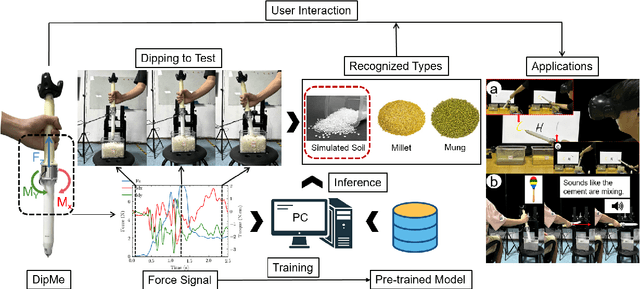



Abstract:While tangible user interface has shown its power in naturally interacting with rigid or soft objects, users cannot conveniently use different types of granular materials as the interaction media. We introduce DipMe as a smart device to recognize the types of granular media in real time, which can be used to connect the granular materials in the physical world with various virtual content. Other than vision-based solutions, we propose a dip operation of our device and exploit the haptic signals to recognize different types of granular materials. With modern machine learning tools, we find the haptic signals from different granular media are distinguishable by DipMe. With the online granular object recognition, we build several tangible interactive applications, demonstrating the effects of DipMe in perceiving granular materials and its potential in developing a tangible user interface with granular objects as the new media.
Seed-Music: A Unified Framework for High Quality and Controlled Music Generation
Sep 13, 2024



Abstract:We introduce Seed-Music, a suite of music generation systems capable of producing high-quality music with fine-grained style control. Our unified framework leverages both auto-regressive language modeling and diffusion approaches to support two key music creation workflows: \textit{controlled music generation} and \textit{post-production editing}. For controlled music generation, our system enables vocal music generation with performance controls from multi-modal inputs, including style descriptions, audio references, musical scores, and voice prompts. For post-production editing, it offers interactive tools for editing lyrics and vocal melodies directly in the generated audio. We encourage readers to listen to demo audio examples at https://team.doubao.com/seed-music .
Towards Linguistic Neural Representation Learning and Sentence Retrieval from Electroencephalogram Recordings
Aug 08, 2024



Abstract:Decoding linguistic information from non-invasive brain signals using EEG has gained increasing research attention due to its vast applicational potential. Recently, a number of works have adopted a generative-based framework to decode electroencephalogram (EEG) signals into sentences by utilizing the power generative capacity of pretrained large language models (LLMs). However, this approach has several drawbacks that hinder the further development of linguistic applications for brain-computer interfaces (BCIs). Specifically, the ability of the EEG encoder to learn semantic information from EEG data remains questionable, and the LLM decoder's tendency to generate sentences based on its training memory can be hard to avoid. These issues necessitate a novel approach for converting EEG signals into sentences. In this paper, we propose a novel two-step pipeline that addresses these limitations and enhances the validity of linguistic EEG decoding research. We first confirm that word-level semantic information can be learned from EEG data recorded during natural reading by training a Conformer encoder via a masked contrastive objective for word-level classification. To achieve sentence decoding results, we employ a training-free retrieval method to retrieve sentences based on the predictions from the EEG encoder. Extensive experiments and ablation studies were conducted in this paper for a comprehensive evaluation of the proposed approach. Visualization of the top prediction candidates reveals that our model effectively groups EEG segments into semantic categories with similar meanings, thereby validating its ability to learn patterns from unspoken EEG recordings. Despite the exploratory nature of this work, these results suggest that our method holds promise for providing more reliable solutions for converting EEG signals into text.
Finding Defective Elements in Intelligent Reflecting Surface via Over-the-Air Measurements
Aug 01, 2024Abstract:Due to circuit failures, defective elements that cannot adaptively adjust the phase shifts of their impinging signals in a desired manner may exist on an intelligent reflecting surface (IRS). Traditional way to find these defective IRS elements requires a thorough diagnosis of all the circuits belonging to a huge number of IRS elements, which is practically challenging. In this paper, we will devise a novel approach under which a transmitter sends known pilot signals and a receiver localizes all the defective IRS elements just based on its over-the-air measurements reflected from the IRS. The key lies in the fact that the over-the-air measurements at the receiver side are functions of the set of defective IRS elements. Based on this observation, we propose a bisection based method to localize all the defective IRS elements. Specifically, at each time slot, we properly control the desired phase shifts of all the IRS elements such that half of the considered regime that is not useful to localize the defective elements can be found based on the received signals and removed. Via numerical results, it is shown that our proposed bisection method can exploit the over-the-air measurements to localize all the defective IRS elements quickly and accurately.
Photo2Relief: Let Human in the Photograph Stand Out
Jul 21, 2023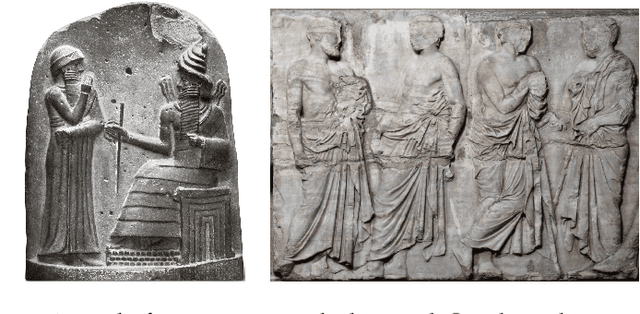

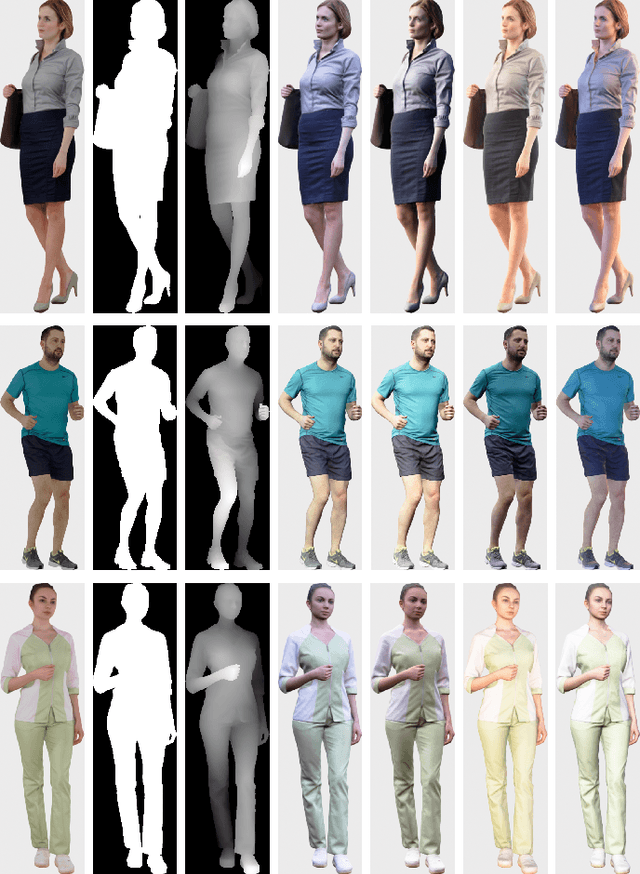
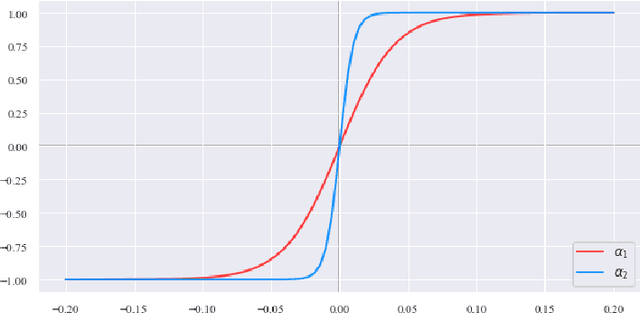
Abstract:In this paper, we propose a technique for making humans in photographs protrude like reliefs. Unlike previous methods which mostly focus on the face and head, our method aims to generate art works that describe the whole body activity of the character. One challenge is that there is no ground-truth for supervised deep learning. We introduce a sigmoid variant function to manipulate gradients tactfully and train our neural networks by equipping with a loss function defined in gradient domain. The second challenge is that actual photographs often across different light conditions. We used image-based rendering technique to address this challenge and acquire rendering images and depth data under different lighting conditions. To make a clear division of labor in network modules, a two-scale architecture is proposed to create high-quality relief from a single photograph. Extensive experimental results on a variety of scenes show that our method is a highly effective solution for generating digital 2.5D artwork from photographs.
A Review of Intelligent Music Generation Systems
Nov 22, 2022
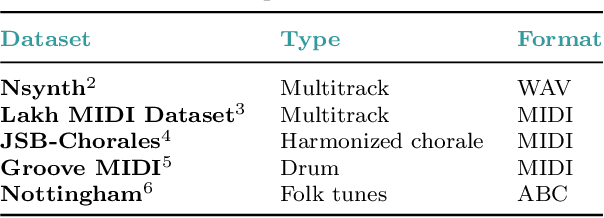
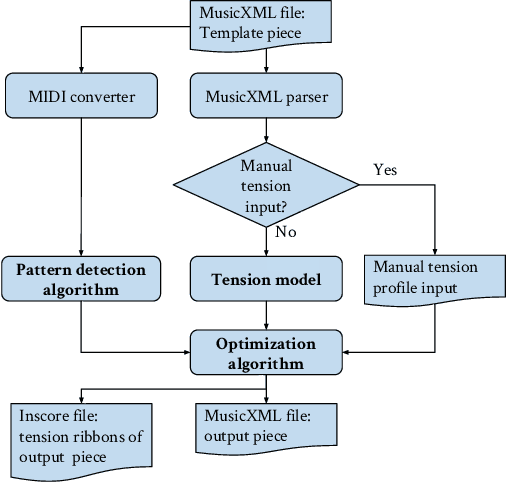

Abstract:Intelligent music generation, one of the most popular subfields of computer creativity, can lower the creative threshold for non-specialists and increase the efficiency of music creation. In the last five years, the quality of algorithm-based automatic music generation has increased significantly, motivated by the use of modern generative algorithms to learn the patterns implicit within a piece of music based on rule constraints or a musical corpus, thus generating music samples in various styles. Some of the available literature reviews lack a systematic benchmark of generative models and are traditional and conservative in their perspective, resulting in a vision of the future development of the field that is not deeply integrated with the current rapid scientific progress. In this paper, we conduct a comprehensive survey and analysis of recent intelligent music generation techniques,provide a critical discussion, explicitly identify their respective characteristics, and present them in a general table. We first introduce how music as a stream of information is encoded and the relevant datasets, then compare different types of generation algorithms, summarize their strengths and weaknesses, and discuss existing methods for evaluation. Finally, the development of artificial intelligence in composition is studied, especially by comparing the different characteristics of music generation techniques in the East and West and analyzing the development prospects in this field.
3D Pose Based Feedback for Physical Exercises
Aug 05, 2022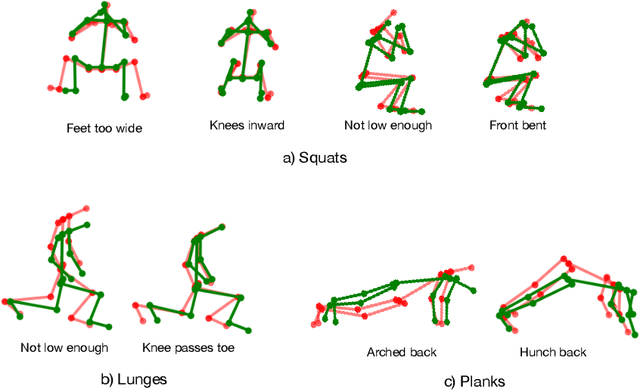
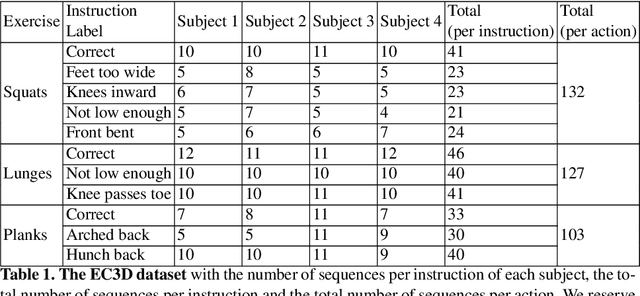
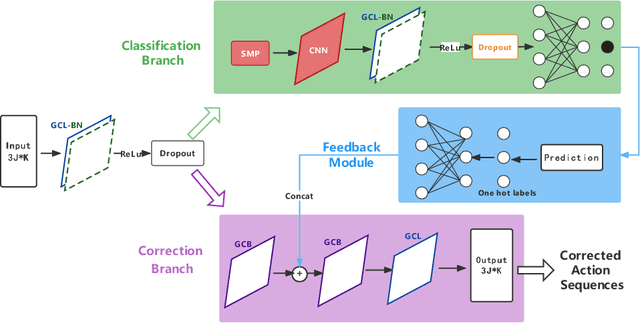
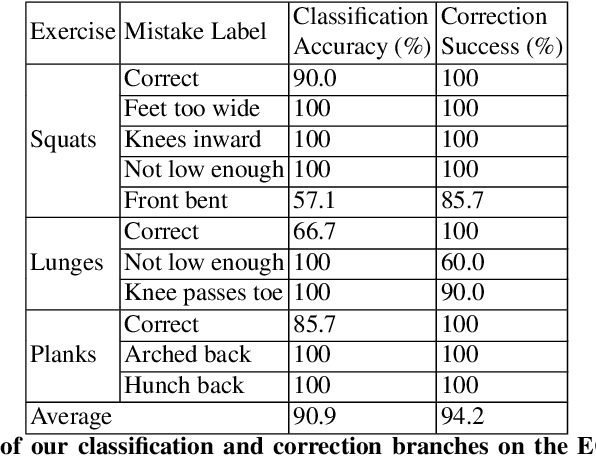
Abstract:Unsupervised self-rehabilitation exercises and physical training can cause serious injuries if performed incorrectly. We introduce a learning-based framework that identifies the mistakes made by a user and proposes corrective measures for easier and safer individual training. Our framework does not rely on hard-coded, heuristic rules. Instead, it learns them from data, which facilitates its adaptation to specific user needs. To this end, we use a Graph Convolutional Network (GCN) architecture acting on the user's pose sequence to model the relationship between the body joints trajectories. To evaluate our approach, we introduce a dataset with 3 different physical exercises. Our approach yields 90.9% mistake identification accuracy and successfully corrects 94.2% of the mistakes.
 Add to Chrome
Add to Chrome Add to Firefox
Add to Firefox Add to Edge
Add to Edge